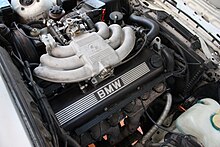
The BMW 3 Series is a line of compact executive cars manufactured by the German automaker BMW since May 1975. It is the successor to the 02 Series and has been produced in seven generations.

The BMW M10 is a SOHC inline-4 petrol engine which was produced by BMW from 1962-1988. It was the company's first four-cylinder engine since the BMW 309 ended production in 1936 and was introduced in the New Class sedans.

The BMW M20 is a SOHC straight-six petrol engine which was produced from 1977 to 1993. It was introduced eight years after the larger BMW M30 straight-six engine, which remained in production alongside the M20.

The BMW M40 is an SOHC straight-four petrol engine which was produced from 1987–1994. It served as BMW's base model four-cylinder engine and was produced alongside the higher performance BMW M42 DOHC four-cylinder engine from 1989 onwards.

The BMW M42 is a DOHC straight-four petrol engine which was produced from 1989-1996. It is BMW's first mass-production DOHC engine and was produced alongside the BMW M40 SOHC four-cylinder engine as the higher performance engine.

The BMW S14 is a DOHC four-cylinder petrol engine which was used in the E30 M3, E30 320iS, and E36 318i Super Touring. It is based on the BMW M10 block and what is essentially a shortened BMW S38 cylinder head. The direct successor to the S14 was the S42 based on the M42 engine. The S42 was a racing engine installed in the E36 320i for the German Super Tourenwagen Cup. There is no direct successor to the S14 for production BMWs, since the following generation of M3 is powered by the BMW S50 six-cylinder engine.

The BMW M50 is a straight-6 DOHC petrol engine which was produced from 1990 to 1996. It was released in the E34 520i and 525i, to replace the M20 engine.

The BMW M52 is a straight-6 DOHC petrol engine which was produced from 1994 to 2000. It was released in the E36 320i, to replace the M50. The BMW S52 engine is a high performance variant of the M52 which powered the American and Canadian market E36 M3 from 1996 to 1999.

The BMW E21 is the first generation of the BMW 3 Series, a range of compact executive cars. The E21 was produced from June 1975 to December 1983 and replaced the BMW 02 Series. The series was exclusively built in a two-door coupé body style. Contrary to its predecessor, a 'Touring' body with a sloped rear hatch was no longer offered.

The third generation of the BMW 3 Series range of compact executive cars is designated under the model code E36, and was produced by the German automaker BMW from 1990 to 2000. The initial models were of the four-door saloon body style, followed by the coupé, convertible, wagon ("Touring"), and eventually hatchback ("Compact").

The BMW 3 Series (E46) is the fourth generation of the BMW 3 Series range of compact executive cars manufactured by German automaker BMW. Produced from 1997 to 2006, it was the successor to the E36 3 Series, which ceased production in 2000. It was introduced in November 1997, and available in sedan, coupé, convertible, station wagon and hatchback body styles. The latter has been marketed as the 3 Series Compact.

The fifth generation of the BMW 3 Series range of compact executive cars is designated under the model codes E90 (saloon), E91, E92 (coupé) and E93 (convertible). The model was introduced in December 2004, and produced by BMW until October 2013 and is often collectively referred to as the E90 or E9x.

The BMW M3 is a high-performance version of the BMW 3 Series, developed by BMW's in-house motorsport division, BMW M GmbH. M3 models have been produced for every generation of 3 Series since the E30 M3 was introduced in 1986.

BMW M GmbH, formerly known as BMW Motorsport GmbH, is a subsidiary of BMW AG that manufactures performance cars.

The BMW 3 Series Compact is a car which was produced from 1994 through 2004 by BMW. It is a 3-door hatchback version of the BMW 3 Series through two generations, for the E36 platform in 1993 and E46 platform in 2001. Unlike most hatchback competitors which were transverse engine front-wheel drive, the 3 Series Compact uses the longitudinal engine rear-wheel drive layout.

The BMW Z1 is the first model in BMW's line of Z series roadsters, and was produced in limited numbers from 1989 to 1991.

The BMW N46 is a naturally aspirated inline-four piston engines which replaced the BMW N42 and was produced from 2004 to 2015.

The BMW N52 is a naturally aspirated straight-6 petrol engine which was produced from 2004 to 2015. The N52 replaced the BMW M54 and debuted on the E90 3 Series and E63 6 Series.

The sixth generation of the BMW 3 Series consists of the BMW F30, BMW F31 and BMW F34 compact executive cars. The F30/F31/F34 generation was produced from October 2011 to 2019 and is often collectively referred to as the F30.







































